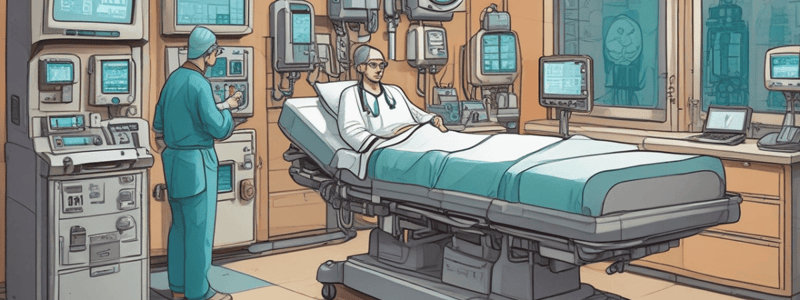Podcast
Questions and Answers
What is the main use of Neuromuscular blocking drugs (NMBDs) during surgical procedures?
What is the main use of Neuromuscular blocking drugs (NMBDs) during surgical procedures?
- To maintain controlled ventilation (correct)
- To reduce blood pressure
- To relieve pain
- To induce general anesthesia
What is the mechanism of action of nondepolarizing NMBDs?
What is the mechanism of action of nondepolarizing NMBDs?
- They bind to acetylcholine receptors and block the usual action of acetylcholine (correct)
- They bind to muscarinic receptors and stimulate muscle contraction
- They bind to autonomic ganglia and stimulate muscle contraction
- They bind to acetylcholine receptors and stimulate muscle contraction
Which of the following is an indication for the use of succinylcholine?
Which of the following is an indication for the use of succinylcholine?
- To reduce muscle contraction in an area that needs surgery
- During long surgical procedures
- To facilitate endotracheal intubation (correct)
- As a diagnostic drug for myasthenia gravis
What is the primary adverse effect of pancuronium?
What is the primary adverse effect of pancuronium?
What is the difference between depolarizing and nondepolarizing NMBDs?
What is the difference between depolarizing and nondepolarizing NMBDs?
Which of the following is a short-acting nondepolarizing NMBD?
Which of the following is a short-acting nondepolarizing NMBD?
Why does succinylcholine cause flaccid muscle paralysis?
Why does succinylcholine cause flaccid muscle paralysis?
What is the primary use of pancuronium?
What is the primary use of pancuronium?
Which type of regional anesthesia involves injecting an anesthetic solution into the epidural space, without penetrating the dura?
Which type of regional anesthesia involves injecting an anesthetic solution into the epidural space, without penetrating the dura?
What is the primary mechanism of action for local anesthetics?
What is the primary mechanism of action for local anesthetics?
Which of the following statements is TRUE about local anesthetic administration?
Which of the following statements is TRUE about local anesthetic administration?
Which of the following is a common application of lidocaine?
Which of the following is a common application of lidocaine?
What is a potential systemic adverse effect of local anesthesia?
What is a potential systemic adverse effect of local anesthesia?
What is the term used to describe the simultaneous use of general anesthetics and adjunct drugs?
What is the term used to describe the simultaneous use of general anesthetics and adjunct drugs?
What is the main purpose of using adjunct anesthetics?
What is the main purpose of using adjunct anesthetics?
Which of the following is NOT an example of an adjunct anesthetic?
Which of the following is NOT an example of an adjunct anesthetic?
What is the primary mechanism of action of general anesthetics?
What is the primary mechanism of action of general anesthetics?
How do fat-soluble drugs differ from water-soluble drugs in terms of their anesthetic properties?
How do fat-soluble drugs differ from water-soluble drugs in terms of their anesthetic properties?
What is the main characteristic of malignant hyperthermia?
What is the main characteristic of malignant hyperthermia?
Study Notes
Adjunct Anesthetics
- Also known as "helper drugs" that complement the use of general anesthetics
- Used simultaneously with general anesthetics for:
- Anesthesia induction
- Sedation
- Reduction of anxiety
- Amnesia
Types of Adjunct Anesthetics
- Neuromuscular blocking agents
- Sedative hypnotics or anxiolytics
- Propofol, benzodiazepines, barbiturates, hydroxyzine, and promethazine
- Opioid analgesics
- Anticholinergics (atropine)
- Antiemetics (ondansetron)
Mechanism of Action and Drug Effects
- Fat-soluble drugs are stronger anesthetics than water-soluble drugs
- General anesthetics produce a progressive reduction of sensory and motor CNS functions
- The degree and speed of this process vary with the anesthetics and adjuncts used along with their dosages and routes of administration
Adverse Effects
- Sites primarily affected:
- Heart (myocardial depression)
- Peripheral circulation
- Liver
- Kidneys
- Respiratory tract
- Malignant hyperthermia is an uncommon, but potentially fatal, adverse effect
Neuromuscular Blocking Drugs (NMBDs)
- Prevent nerve transmission in skeletal and smooth muscles, leading to paralysis
- Often used as adjuncts with general anesthetics
- Classified into two groups based on mechanism of action:
- Depolarizing (e.g., succinylcholine)
- Non-depolarizing (e.g., mivacurium, atracurium, rocuronium, vecuronium)
Indications for NMBDs
- Maintaining controlled ventilation during surgical procedures
- Endotracheal intubation (short-acting)
- Reducing muscle contraction in an area that needs surgery
- Diagnostic drugs for myasthenia gravis
Adverse Effects of NMBDs
- May cause:
- Hypotension (blockade of autonomic ganglia)
- Tachycardia (blockade of muscarinic receptors)
- Hypotension (release of histamine)
Specific NMBDs
- Succinylcholine:
- Metabolized more slowly than Ach
- Most commonly used to facilitate endotracheal intubation
- Pancuronium:
- Long-acting non-depolarizing NMBD
- Most commonly employed for long surgical procedures that require prolonged muscle paralysis
Types of Local Anesthesia
- Central:
- Spinal or intraspinal anesthesia
- Intrathecal anesthesia: involves injection of anesthesia into the subarachnoid space
- Epidural anesthesia: involves injection of anesthesia via a small catheter into the epidural space without puncturing the dura
- Peripheral:
- Infiltration: small amounts of anesthetic solution are injected into the tissue that surrounds the operative site
- Nerve block: anesthetic solution is injected at the site where the nerve innervates a specific area
- Topical anesthesia: the anesthetic drug is applied directly onto the surface of the skin, eye, or any mucous membrane to relieve pain or prevent it from being sensed
Mechanism of Action and Drug Effects of Local Anesthetics
- Local anesthetics work by rendering a specific portion of the body insensitive to pain by interfering with nerve transmission in that area
- They block the generation and conduction of impulses through all types of nerve fibers by blocking the movement of certain ions important to this process
Adverse Effects of Local Anesthetics
- Possible systemic effects of the administration of local anesthetics include effects on circulatory and respiratory function
- The systemic adverse effects depend on where and how the drug is administered
- Such adverse effects are somewhat unlikely unless large quantities of a drug are administered
Specific Local Anesthetics
- Lidocaine:
- One of the most commonly used local anesthetics
- Available in several strengths, both alone and in different concentrations with epinephrine, and is used for both infiltration and nerve block anesthesia
- Also available in topical form
- Parenteral lidocaine is also used to treat certain cardiac dysrhythmias
Studying That Suits You
Use AI to generate personalized quizzes and flashcards to suit your learning preferences.
Related Documents
Description
This quiz covers the use of adjunct anesthetics, also known as 'helper drugs', to complement general anesthetics in anesthesia induction, sedation, anxiety reduction, and amnesia. It explores the different types of adjuncts, including neuromuscular blocking agents, sedative hypnotics, opioids, and anticholinergics.




